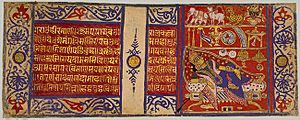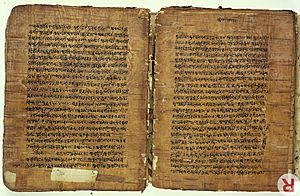Sutra facts for kids
A Sutra (pronounced SOO-tra) is an important type of ancient text from India. The word comes from Sanskrit and means "string" or "thread." Think of it like a string that holds together many important ideas or rules.
Sutras are often short, clear statements, like a rule or a theorem, that help explain big ideas. These texts are found in three major religions that started in India: Hinduism, Buddhism, and Jainism. They were created to help teachers pass on knowledge and wisdom to their students, making it easier to remember and understand complex teachings.
In Hinduism, Sutras are like short, wise sayings. They cover many topics, from religious rituals and philosophy to grammar and rules for daily life. The oldest Hindu Sutras are found in parts of the Vedas, which are very ancient holy books.
For Buddhists, Sutras (also called suttas) are important scriptures. Many of them are believed to be the actual teachings of Gautama Buddha. Unlike Hindu Sutras, Buddhist Sutras are often quite long and detailed, not just short sayings.
In Jainism, Sutras (also called suyas) are like sermons or rules from Mahavira, a very important figure in Jainism. They are part of the Jain Agamas, which are sacred texts.
Contents
What Does "Sutra" Mean?
The word Sūtra comes from the Sanskrit word "siv," which means "to sew" or "to hold things together." This is why it means "string" or "thread."
Imagine a string holding beads together. In the same way, a Sutra is a short collection of words that holds together important teachings. It's like a rule or a guide that connects different parts of knowledge.
A Sutra is a very short rule, like a "theorem condensed in few words." When many Sutras are put together, they form a whole text, which is also called a Sutra.
Sutras are different from other types of ancient Indian writings. For example, a Shloka is a full verse with a complete message, often following musical rules. A Sutra is much shorter and more direct, just stating a rule or an idea very clearly.
A Brief History of Sutras
Sutras first appeared in the oldest parts of the Vedic literature, like the Brahmana and Aranyaka texts. They became more common in later Vedic writings, such as the Shrauta Sutras. These texts were designed to be easy for teachers to share with students and for students to memorize.
A Sutra by itself can be very short and hard to understand without help. It's like a shorthand note. To fully understand them, people often needed special commentaries called Bhasya, which explained the deeper meaning.
Some of the oldest surviving Sutra manuscripts are part of the Vedas, dating back thousands of years. Historians believe that a special "sutras period" in Indian literature happened between 600 BCE and 200 BCE. During this time, many large collections of Sutras were created in different areas of knowledge.
The famous scholar Max Muller once said that ancient Indian students learned these Sutras of grammar, philosophy, or religion in the same way modern students learn the alphabet or multiplication tables – by memorizing them.
Sutras in Hinduism
In Hinduism, Sutras are a key part of many important texts. Some of the earliest Hindu Sutras that still exist today include the Anupada Sutras and Nidana Sutras. The Anupada Sutras discuss how to find reliable knowledge, while the Nidana Sutras explain the rules for musical meters used in ancient chants.
A large group of ancient Hindu Sutras are related to the six Vedangas. These are six subjects that were considered important for truly understanding the Vedas. Each of these subjects had its own Sutras:
- Shiksha (pronunciation)
- Chandas (meter)
- Vyakarana (grammar)
- Nirukta (explanation of words)
- Jyotisha (timekeeping using astronomy)
- Kalpa (ceremonial rituals)
These Sutras helped people read, understand, and use the knowledge from the Vedas, especially for religious ceremonies. Even parts of the Upanishads, which are philosophical texts within the Vedas, contain Sutras.
Many other ancient Hindu Sutra texts have survived, either completely or in parts. These include the Kalpa Sutras, Shulba Sutras, Srauta Sutras, Dharma Sutras, and Grhya Sutras.
Important Post-Vedic Sutras
After the Vedic period, many other important Sutra texts were created in different schools of Hindu philosophy. Here are a few examples:
- Brahma Sutras: Written by Badarayana, this text has 555 Sutras that summarize the deep philosophical ideas found in the Upanishads. It's a very important text for the Vedānta school of Hindu philosophy.
- Yoga Sutras: This famous text, put together by Patanjali around 400 CE, contains 196 Sutras about Yoga. It explains the eight steps of Yoga and meditation. It has been very influential in India and has been translated into many languages.
- Vaisheshika Sutra: Written by Kanada, this text from ancient times (between 4th and 1st century BCE) has 370 Sutras. It teaches about naturalism, how we gain knowledge, and the nature of reality.
- Nyaya Sutras: Composed by Akṣapada Gautama, this text focuses on knowledge and logic. It has 528 Sutras that explain rules for reasoning, logic, and how we know things. It's divided into five books, covering different aspects of knowledge.
- Mimamsa Sutras: Written by Jaimini, this text is about the Mimamsa school of Hinduism. It focuses on the early parts of the Vedas, especially rituals and religious actions, as a way to achieve salvation. It has nearly 2700 Sutras.
- Dharma-sutras: These Sutras, by authors like Āpastamba and Gautama, give rules and guidelines for righteous living and social ethics.
- Artha-sutras: Texts like the Niti Sutras of Chanakya are about how to govern, laws, economics, and politics. The famous Arthashastra by Chanakya is also written in a Sutra-like style.
Sutras in Buddhism
|
Basic terms |
|
|
People |
|
|
Schools |
|
|
Practices |
|
|
study Dharma |
|
In Buddhism, a sutta or sutra is a part of the sacred texts. Unlike Hindu Sutras, early Buddhist Sutras are usually not short sayings. Instead, they are often quite long and detailed. The Buddhist word sutta likely comes from a Sanskrit word meaning "well spoken." This shows the belief that "all that was spoken by the Lord Buddha was well-spoken." They are like sermons that share "well-spoken" wisdom.
In Chinese, these texts are known as jīng. These teachings are organized into a collection called the Tripiṭaka, specifically in the Sutta Pitaka. Many important Buddhist texts, like the Lotus Sutra, are called Sutras, even if they were written much later.
In Theravada Buddhism, the Suttas are the second main collection of texts in the Pāli Canon. They contain the Buddha's talks and teachings that he gave over 45 years.
Sutras in Jainism
In the Jain tradition, Sutras are a very important type of "fixed text" that people used to memorize.
For example, the Kalpa Sūtra is a Jain text that includes rules for monks and nuns, as well as stories about the lives of the Jain Tirthankaras (great teachers). Many Sutras discuss all parts of life for both monks and regular people in Jainism. Some ancient Sutras even suggest that devotion (bhakti) is an important Jain practice.
The surviving holy books of the Jain tradition, like the Acaranga Sutra (part of the Agamas), are written in Sutra format. Another key text is the Tattvartha Sutra, which is accepted by all Jain groups as the most important philosophical text that explains the basic ideas of Jainism.
See also
- Ananda Sutram
- Chinese Buddhist canon
- List of suttas
- Sastra
- Sutra copying
- Sutram
- Tibetan Buddhist canon
Images for kids






